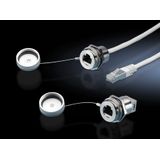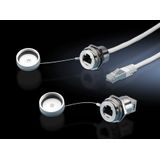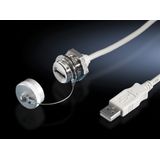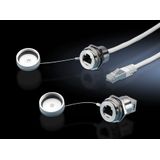Rittal Telecommunication cables and wires






rittal telecommunication cables and wires for networks and control
For panel rooms and IT‑adjacent spaces, consistent cable spec is what keeps commissioning predictable. The focus here is on conductor classes, shielding, CPR fire classes, and bend/length rules that let crews deliver stable 1G/10G Ethernet and noise‑robust control runs inside and between Rittal enclosures.
rittal communication cables product range and series overview
Copper twisted pair — Cat5e/Cat6/Cat6A, 100 Ω, 24–23 AWG conductors; U/UTP for low‑noise rooms and F/UTP, S/FTP where VFDs or long parallel runs demand shielding. Solid conductors for fixed links; stranded patch leads for doors and device jumpers. Bandwidth classes: Cat5e 100 MHz (1G), Cat6 250 MHz (1G short/2.5G), Cat6A 500 MHz (10G).
Fiber backbones — OM3/OM4 multimode for short‑to‑mid uplinks; OS2 single‑mode for campus/outdoor ducts. Tight buffers for cabinet routes, loose‑tube for building risers.
Low‑voltage signal/control — multicore data/control pairs for PLC I/O and sensors, screened (AL/PET + drain) where EMC is critical. Fine‑strand Class 5 for door loops and flexible whips.
Jacket options cover PVC for standard interiors and LSZH for public spaces. Color coding follows TIA/EIA or site policy so service can read the route at a glance.
rittal twisted pair cabling technical specifications and standards
- Standards: structured cabling to ISO/IEC 11801‑1, EN 50173; performance verification to IEEE 802.3 Ethernet. Patch cords follow IEC 60603‑7 connector families. Control/data multicore design per IEC 60228 conductor classes.
- Channel geometry: permanent link 90 m, total channel 100 m with stranded patch at ends; avoid consolidation points unless documented. Maintain pair twist to the IDC to preserve NEXT/PSANEXT.
- PoE capability: support for IEEE 802.3af/at/bt (up to ~90 W) on Cat6/Cat6A with conductor gauge and bundle temperature rise considered. Use high‑temp LSZH where large bundles run warm.
- Shielding: U/UTP for benign EMI; F/UTP, S/FTP where VFDs, relays, or long parallel mains exist. Bond shields 360° at EMC plates; keep pigtails short.
- Fire & CPR: jackets rated to EN 50575 with classes Eca/Dca/Cca/B2ca depending on building segment; flame tests per EN 60332‑1‑2 and smoke/acid gases per EN 61034/EN 60754 for LSZH.
- Environment: operating typically −20…+60/75 °C (check polymer); bend radius ≥4× OD fixed, ≥8× OD dynamic. UV‑stable sheaths for outdoor conduits.
Document measured link parameters (NEXT, RL, ACR‑F) during FAT; it closes the loop with the cabinet grounding and entry hardware used
rittal data transmission wires applications and compatibility
- Cabinet‑to‑cabinet links: Cat6A solid in ladder trays or profiles; fiber OM4/OS2 for EMI‑heavy or long runs. Keep separation from mains; cross at 90° where paths meet.
- Door stations and HMIs: stranded patch from the door to the internal switch; add strain relief bars and brush plates to maintain bend and IP.
- PLC/drive bays: screened copper with 360° bonds at the plate; avoid shared metalwork with high‑current routes.
All families route cleanly through Rittal gland/adapter plates, strain‑relief bars and duct. Marker systems match terminal pitch and front‑of‑rack labels for faster fault‑finding.
Integration with other Rittal products
Combine cable entries with EMC gland plates and bonding kits so shield continuity sits at the enclosure wall. Use TS35 clamp rails just inside the entry to intercept mechanical load, and choose wiring duct sizes that preserve bend radius for Cat6A and fiber. Where fiber meets copper, house the transition in a shallow patch box fixed to depth rails.
rittal signal wires selection criteria for B2B clients
- Bandwidth and link length — Cat5e for short 1G, Cat6 for 1G with margin, Cat6A for 10G and PoE‑bt bundles; fiber where EMI or distance defeats copper.
- CPR and environment — LSZH with documented EN 50575 class for public routes; UV‑stable jackets outdoors; temperature headroom in bundles with PoE.
- Shielding strategy — unshielded in quiet panels; F/UTP or S/FTP next to drives/relays. Always 360° terminate at the entry.
- Conductor class — solid for fixed links; stranded for flex/doors. Respect bend radius and strain‑relief spacing.
- Labeling and service — harmonize colors and legends across bays; include test results in the handover pack.
Where campuses repeat the same cabinet layouts, standardize one Cat6A line, one LSZH fiber family (OM4/OS2), and a screened multicore for control—spares and training become trivial.
Advantages of working with Bankoflamps
We align commercial terms with your BOM via individual B2B pricing and formal offers, assign a dedicated account manager, and expose live EU‑wide stock for planning. Quotes typically arrive in about an hour. Orders submit by EAN/MPN with clean traceability, and price lists are downloadable and kept current. You get lead‑time and order‑status tracking plus purchase‑history analytics to consolidate SKUs. Trusted clients receive up to 30 days post‑payment. We also plan consolidated shipments to cut freight costs, hold prices with validity dates, and support teams in France, the Baltics, Germany, Spain, Italy, Belgium, and the Netherlands.